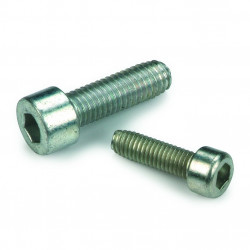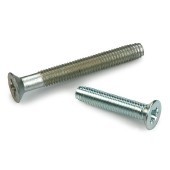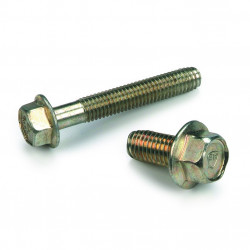Self-forming screws eliminate the need for tapping. Available in metric threads, they can be replaced by standard screws. The trilobular cross-section facilitates forming during screwing. The advantages are as follows: Reduced assembly costs, greater resistance to loosening and vibration, chip-free assembly, high pull-out resistance (greater than 30% compared to traditional assembly). Applications: public equipment and goods, hospitals, urban equipment, railways, aeronautics, etc...
What is a self-forming screw?
A self-forming screw, also known as a self-tapping screw, is a screw designed to cut or form its own thread inside a material without the need for pre-tapping. This means that, instead of having to pre-drill a threaded hole, the screw forms its own thread as it is screwed into the material, such as steel, aluminum or plastic. This type of screw differs from self-drilling screws, which feature a drill point capable of piercing the material before forming the thread, making them particularly useful in situations where rapid installation without additional tools is required.
Advantages of self-forming screws over traditional screws
One of the great advantages of self-forming screws is that they save time and eliminate steps during installation. Unlike traditional screws, which often require pre-drilling and tapping, these screws can be inserted directly into a material, reducing the complexity of the process and the need for additional tools. What's more, they offer increased strength, particularly in applications where thread strength is essential.
Materials suitable for self-forming screws
Self-forming screws are compatible with a variety of materials including:
Metals: steel, stainless steel, aluminum.
Plastics: especially hard plastics such as polycarbonate.
Dense woods: they can sometimes be used in hardwood species, although they are primarily designed for metal or synthetic materials.
However, it's crucial to use the right self-shaping screw for each material. For example, a screw designed for metal would not be as effective in wood or plastic.
When to use self-shaping screws?
Common industrial uses
Self-forming screws are widely used in many industries, including automotive, electronics and machine building. They are ideal for assemblies requiring high mechanical strength and precision. For example, in the automotive industry, they are often used to assemble metal panels, where they create a durable fastening without the need for prior tapping.
Use in DIY and small-scale construction
Do-it-yourselfers particularly appreciate self-forming screws for their ease of use. They are frequently used to fasten sheet metal, metal plates or plastic panels, without having to drill a pilot hole or use taps. For example, to fasten a plastic box or lightweight metal support to a steel surface, self-tapping screws offer a fast, secure way of making the assembly.
In electrical engineering, for example, they are commonly used to secure wiring boxes to metal surfaces. Similarly, in lightweight construction, they can be used to fasten thin steel or aluminum components without the need for pre-drilling - a considerable time-saver.
What drilling diameter for self-forming screws?
Material diameter and thickness
The choice of drilling diameter for a self-forming screw depends on a number of factors, including the type of material and its thickness. As a general rule, we recommend choosing a drilling diameter slightly smaller than the diameter of the screw itself, so that the screw can form its thread in the material. For example, for a 4 mm self-forming screw, a 3.5 mm hole might be appropriate.
Manufacturers' recommendations
Self-forming screw manufacturers generally provide precise recommendations for the ideal drilling diameter. It is essential to follow these guidelines to avoid fastening problems or incorrect threading. Too large a diameter may prevent the screw from securing properly, while too small a diameter may damage the screw or the material.
Mistakes to avoid when drilling
The most common mistake is to ignore the thickness of the material. A hole too small in a thick material can cause the screw to break, while a hole too large in a thin material can result in poor hold. It is therefore crucial to choose the right diameter for the specific project.
How to drill self-forming screws?
To install self-forming screws correctly, you'll need an electric drill with a bit adapted to the type of screw chosen. We also recommend using an impact driver for more resistant materials, to avoid forcing the screw.
To insert self-tapping screws correctly:
- Choosing the right screw size : Make sure the screw length and diameter are appropriate for the thickness and type of material.
- Drill hole : Use a drill to create a hole slightly smaller than the screw diameter.
- Inserting the screw: Place the self-tapping screw in the hole and start tightening with an electric screwdriver. The screw will create its own thread as it is inserted.
- Finishing : Screw inuntil the screw head is flush with the surface, without forcing to avoid damaging the material.
To ensure the durability of your installation, we recommend that you do not overtighten self-tapping screws. Overtightening can damage the thread or cause the screw to break.
It is also advisable to use stainless steel screws for outdoor applications, to avoid corrosion.













